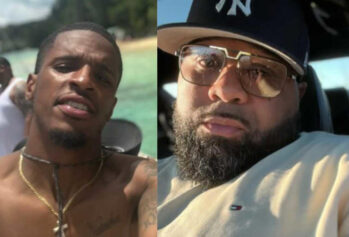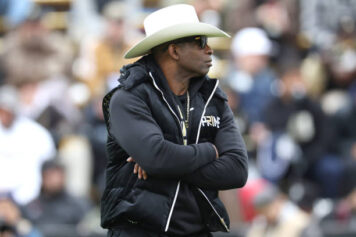Growing up, as a Bulls fan, I had many reasons to have a great disdain towards No.33, but not for real, for real. Deep down, I wasn't right. The recalcitrance in regards to the 7-foot phenom was in fact childish. I judged the Hall of Famer by his affiliation with the hated Knicks and his inability to collect shiny balls at the same rate as Air Jordan, when in fact all great players of that period succumbed to the will of MJ and Phil Jackson’s Bulls Dynasty. Bulls fans back then were as disillusioned and spoiled as Yankees fans of the Derek Jeter Era. I was blinded by allegiance, but my family refused to let me be basketball dumb.
One day, one of my uncles pulled me aside and not only told me how bogus I was, but started telling me about the legend who is Patrick Aloysius Ewing and how he not only revolutionized basketball culture, but how his Georgetown teams were symbols of pride and strength for the entire African-American community.
So yeah, I got on my knowledge-gathering steeze and was thoroughly impressed. How could my prepubescent self be so petty? How could I stunt on him? Ewing has always been cold. No fancy adjectives necessary, sir. He is perhaps the greatest college basketball player ever and certainly one of the most influential and memorable.
A blocking machine. A 62 percent college career shooter. A gold-medal member of the legendary 1992 Olympic “Dream Team.” Consensus All-American pick (‘83,’84, ‘85). NCAA Basketball Tournament Most Outstanding Player (1984). Adolph Rupp Trophy and Naismith winner, AP and Sporting News College Player of the Year (1985). Let’s not forget his freshman campaign (’81-'82 season) when he led the Hoyas to the title game. He did it three times in total, winning the championship in 1984 against rival center Hakeem Olajuwon.
Legendary rapper Phife Dawg from ATCQ began his come-up during the golden age of Big East basketball. He says Patrick Ewing is a Top 3 most influential player in Big East history.
Remember when Jadakiss spit the line, ‘the Jew lawyer, the true employer, who will destroy ya' defense like the Hoyas?" Phife asked.
"That was a Patrick Ewing reference. He was unstoppable on both sides of the ball. He was the ultimate defender and he shredded opposing D’s. He came from the West Indies. That population was exploding in the U.S., during that time. He was probably teased for being so tall but eventually he was able to make a lot out of that. Why? Because (Georgetown coach John Thompson) is a father to his players. Patrick’s skill set speaks for itself and he got better every year. Remember the beginning of that ‘82 title game against UNC when he caught five goal tends in the first half. It sent a message to the world that ‘Yo, this dude is a monster.’ The Tar Heels were going to have to earn it if they came in the paint. That was his territory. Big East territory."
"UOENO" it! He's start-your-franchise-around-
Born in Kingston, Jamaica, Ewing excelled at cricket and soccer. At an early age, The Boston-bred center developed a resilient determination. Much like a drill sergeant mindful of leading his brigade to victory, Ewing was quite militant when it came time to getting W's. Between a growth spurt to 7-feet by his senior season, an increased scoring punch his junior and senior year (averaged 17 points and 23 points respectively) in addition to a gang of wins, Ewing's buzz coming out of Cambridge High was dumb crazy. He was the highest touted college player since Lewis Alcindor.
Fortunately, for renowned Hoyas coach John Thompson – iconized as a giant who cultivated black boys into men – the prodigy landed in his lap and transformed the fate of both men forever. Ewing was an impenetrable force in college and to this day, the most defensively intimidating presence in Big East-era, college hoops.
In those years, Thompson and Ewing sparked an athletic and cultural revolution and re-directed college basketball’s focus on the East Coast and the flashy, gritty, aggressive, intimidating and cocky brand of ball that was sweeping the nation. It also became the breeding and feeding ground for an upstart all-sports cable station named ESPN.
“The Big East Conference and hip-hop music blew up about the same time, the mid to late 80’s into the early 90’s,” said rapper and sports aficionado Masta Ace. “Then the street fashion changed to match what the ball players were wearing. Then cable TV started bringing them into homes across the country. They were like the local drug dealers in stature. You had the St John’s Starter jacket, your Syracuse basketball outfit, Your Georgetown Nikes and starter jackets."
"Ewing and the Hoyas were the team that really created a fashion culture. Before these guys came on the scene, ball players wore collared shirts and slacks. Then Ewing’s Hoyas hit the scene with an urban swag never highlighted on prestigious college campuses. They wore sweat suits and sneakers and hats with team logos and names. That culture oozed into the streets and dictated one’s allegiance to a team. We rocked the summer shorts with the pro logos plastered on them and the college team boxers."
"You definitely had G-town because the whole team was us, Black, so we embraced them immediately. They were a source of pride at a time when gang violence and crack was ripping communities apart. Although I loved being from NY and I supported my Brooklyn homie Dwayne “Pearl” Washington and Syracuse; we still rocked with Georgetown.”
So basically unc broke it down to the very last compound about P Ewing. His pro career was also auspicious as he was among the Top 3 centers in the game. He was an 11-time All-Star and carried the murderous burden of performing under the intense NY spotlights. He is currently the associate head coach of the Charlotte Bobcats, working under Steve Clifford, and was inducted into the Hall of Fame on September 5, 2008 along with former NBA coach and Heats President Pat Riley and Olajuwon. His number 33 was retired by the Knicks in 2003.
He also suffers the unfair fate of never winning an NBA title. But Ewing’s cultural impact makes him a player that transcends stats and titles. He was a larger-than-life icon whose size was his greatest weapon and detriment. It made him an unforgettable and captivating presence, but he was expected to be Zues every night. People always assumed that his greatness came easy. Even when he was dripping buckets of sweat at the free throw line, wiping his drenched face with his wrist bands, and icing his battle-scarred knees, he nobly and brashly carried the hopes of an entire college conference and then a c'hip-thirsty, NYC pro franchise on his back. His heart and the style he brought to the mix – especially rocking a t-shirt underneath his jersey – kicked off one of the most epic sports trends in college basketball that exists today.
The soul of March Madness was forever changed when Patrick Ewing rose to the top of the Big Dance tourney titans ranks.



